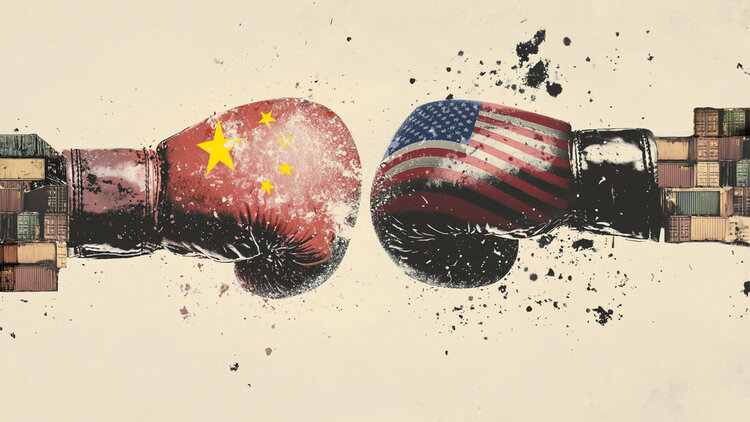Here is what you need to know on Tuesday, June 10:
The US Dollar (USD) stays resilient against its peers in the European session on Tuesday. Investors refrain from taking large positions as they await the outcome of the United States (US)-China trade talks, which are set to continue in London later in the day. The NFIB Optimism Index for May will be the only data featured in the US economic calendar.
US Dollar PRICE Last 7 days
The table below shows the percentage change of US Dollar (USD) against listed major currencies last 7 days. US Dollar was the strongest against the Japanese Yen.
| USD | EUR | GBP | JPY | CAD | AUD | NZD | CHF | |
|---|---|---|---|---|---|---|---|---|
| USD | 0.27% | 0.11% | 1.24% | -0.05% | -0.31% | -0.22% | 0.47% | |
| EUR | -0.27% | -0.13% | 1.01% | -0.29% | -0.56% | -0.40% | 0.21% | |
| GBP | -0.11% | 0.13% | 1.11% | -0.17% | -0.43% | -0.29% | 0.34% | |
| JPY | -1.24% | -1.01% | -1.11% | -1.28% | -1.56% | -1.44% | -0.70% | |
| CAD | 0.05% | 0.29% | 0.17% | 1.28% | -0.32% | -0.13% | 0.52% | |
| AUD | 0.31% | 0.56% | 0.43% | 1.56% | 0.32% | 0.15% | 0.78% | |
| NZD | 0.22% | 0.40% | 0.29% | 1.44% | 0.13% | -0.15% | 0.63% | |
| CHF | -0.47% | -0.21% | -0.34% | 0.70% | -0.52% | -0.78% | -0.63% |
The heat map shows percentage changes of major currencies against each other. The base currency is picked from the left column, while the quote currency is picked from the top row. For example, if you pick the US Dollar from the left column and move along the horizontal line to the Japanese Yen, the percentage change displayed in the box will represent USD (base)/JPY (quote).
In the absence of high-impact data releases, the trading action in financial markets remained relatively subdued at the beginning of the week. Wall Street’s main indexes ended Monday with minimal gains and the USD Index posted small losses. In the European morning on Tuesday, the USD Index trades marginally higher slightly above 99.00, while US stock index futures remain virtually unchanged on the day.
The data published by the UK’s Office for National Statistics (ONS) showed early Tuesday that the ILO Unemployment Rate ticked up to 4.6% in the three months to April from 4.5%, as anticipated. In this period, the annual wage inflation, as measured by the changed in the Average Earnings Excluding Bonus, softened to 5.2% from 5.5%. Finally, the Employment Change was 89K, compared to 112K previously. GBP/USD stays on the back foot and trades below 1.3550.
After ending the first trading day of the week marginally higher, EUR/USD fluctuates in a tight channel at around 1.1400 in the European morning on Thursday. China’s Vice President Han Zheng said on Tuesday that the Chinese government is ready to work with the European Union to further expand areas of cooperation and promote new development in China-EU relations. Later in the session, Sentix Investor Confidence data for June will be featured in the European economic docket.
Bank of Japan (BoJ) Governor Kazuo Ueda repeated on Tuesday that they will raise interest rates if they have enough confidence that underlying inflation nears 2% or moves around 2%. Following Monday’s choppy action, USD/JPY struggles to find direction early Tuesday and trades near 144.50.
AUD/USD moves up and down in a narrow band above 0.6500 in the European morning. The data from Australia showed that the Westpac Consumer Confidence declined to 0.5% in June from 2.2% in May.
Gold held its ground and ended the day in positive territory after dipping below $3,300 in the early Asian session on Monday. XAU/USD stays calm on Tuesday and continues to move sideways above $3,300.
US-China Trade War FAQs
Generally speaking, a trade war is an economic conflict between two or more countries due to extreme protectionism on one end. It implies the creation of trade barriers, such as tariffs, which result in counter-barriers, escalating import costs, and hence the cost of living.
An economic conflict between the United States (US) and China began early in 2018, when President Donald Trump set trade barriers on China, claiming unfair commercial practices and intellectual property theft from the Asian giant. China took retaliatory action, imposing tariffs on multiple US goods, such as automobiles and soybeans. Tensions escalated until the two countries signed the US-China Phase One trade deal in January 2020. The agreement required structural reforms and other changes to China’s economic and trade regime and pretended to restore stability and trust between the two nations. However, the Coronavirus pandemic took the focus out of the conflict. Yet, it is worth mentioning that President Joe Biden, who took office after Trump, kept tariffs in place and even added some additional levies.
The return of Donald Trump to the White House as the 47th US President has sparked a fresh wave of tensions between the two countries. During the 2024 election campaign, Trump pledged to impose 60% tariffs on China once he returned to office, which he did on January 20, 2025. With Trump back, the US-China trade war is meant to resume where it was left, with tit-for-tat policies affecting the global economic landscape amid disruptions in global supply chains, resulting in a reduction in spending, particularly investment, and directly feeding into the Consumer Price Index inflation.

